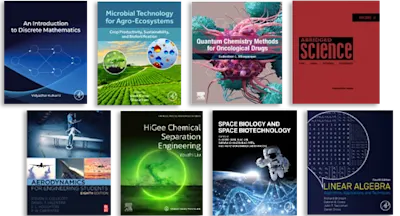
Introduction to the Mechanochemistry of Solids
- 1st Edition - March 1, 2026
- Editors: Adam A.L. Michalchuk, Ana Belenguer, Elena Boldyreva
- Language: English
- Paperback ISBN:9 7 8 - 0 - 4 4 3 - 2 9 9 9 5 - 7
- eBook ISBN:9 7 8 - 0 - 4 4 3 - 2 9 9 9 6 - 4
Mechanochemistry is being heralded as a transformation for green and sustainable chemistry by allowing materials and molecules to be synthesized without need for solvent and both… Read more
Purchase options

- How and why can mechanical treatment help when solution chemistry fails?
- Why might different sample preparation be important for the outcome of mechanical treatment?
- Why does treatment in different devices and/or different protocols of mechanical treatment give different results?
- When and why does adding fluids matter?
- How can we know what happens in a mechanochemical reactor at the moment of treatment?
- Provides a general introduction to the fundamental concepts of mechanochemistry in relation to solid-state reactivity
- Outlines a balance of concepts from a multidisciplinary perspective alongside practical advice
- Chapter features to support better understanding for the reader include ground-up introductions, ‘key concept’ boxes, select case studies to solidify understanding, schematics and flow charts, and concluding ‘knowledge check’ questions for reflection
- Includes an overview of potential applications of mechanochemistry
1. Basic features of solid-state structure
2. Thermodynamic landscape of the solid state
3. Defects: changing solid state stability and reactivity
SECTION II: NATURE OF MECHANOCHEMICAL REACTIONS IN SOLIDS
4. Avenues for reactivity in solids
5. Thermo-mechanical reactivity of solids
6. Reactivity of solids under dynamic mechanical strain
7. Are mechano-chemical reactions always ‘mechano-chemical’?
8. Energetic aspects of solid state mechanochemical reactions
9. Elementary kinetics of mechanochemical reactions
SECTION III: EXPERIMENTAL AND THEORETICAL METHODS TO STUDY SOLID STATE MECHANOCHEMISTRY
10. Solution analytical methods in solid state mechanochemistry
11. Main techniques for solid state characterisation to study mechanochemical reactions (diffraction including Rietveld and microstructure, thermal analysis, etc)
12. Progress in methods to study mechanochemical reactions in situ
13. Theoretical methods to study mechanochemical reactions in solids
14. Designing a mechanochemical reaction from first principles
SECTION IV: APPLICATIONS OF MECHANOCHEMISTRY
15. Mechanochemistry for organic synthesis
16. Mechanochemistry for inorganic synthesis
17. Mechanochemistry for the design of molecular materials (cocrystal, MOF, COF, etc)
18. Mechanochemistry in pharmacy
19. Mechanochemistry of natural materials
20. Mechanochemistry for sustainable chemistry / manufacture
21. Mechanochemistry for industrial applications: scale-up
- Edition: 1
- Published: March 1, 2026
- Language: English
AM
Adam A.L. Michalchuk
AB
Ana Belenguer
Ana Belenguer is a senior research fellow at the Yusuf Hamied Department of Chemistry, University of Cambridge, UK. She has been working with Professor Jeremy Sanders on various projects funded by EPSRC grants since 2002, initially on Dynamic Covalent Chemistry (DCC) in solution. Since 2009 she has been pioneering the field of fundamental studies of solid state DCC by ball mill grinding, focusing on elucidating the driving forces behind mechanochemical reactivity in organic solids.
EB
Elena Boldyreva
Elena Boldyreva is a Leading Researcher at the Boreskov Institute of Catalysis Siberian Branch of Russian Academy of Sciences and a Professor at the Chair of Solid-State Chemistry, Novosibirsk State University. She graduated from Novosibirsk State University in 1982 and received her PhD in Physical Chemistry in 1988 and her Dr. Sci. in Solid State Chemistry in Russia. Elena Boldyreva is an Honorary Doctor of Sciences of the University of Edinburgh, a Corresponding Member of the Academy of Sciences and Arts of Slovenia and a Member of the Academia Europea. She was a Humboldt Fellow and has spent many research terms in Germany, the UK, Italy, and France.
Her main interests are in the reactivity of organic solids, mechanochemistry, high-pressure research, polymorphism of drugs and biomimetics, cocrystals, molecular materials, the properties of hydrogen bonds. She also pioneered studies of the relation between chemical pressure and solid-state reactivity, with particular interest in photo- and thermo- mechanical effects.